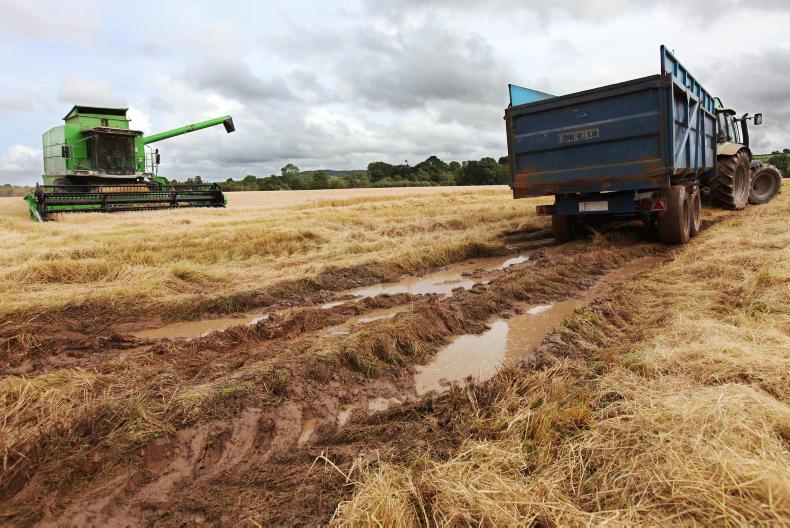The year 2017 will carry different sentiments for different people. Some will remember a good back end in 2016 for planting and growth that set winter crops up with considerable potential for 2017, which many delivered on. For others, a late spring threatened the potential of quality malting and oat crops and when dryness arrived in April and May, along with a fleece of yellowed leaves, most crops appeared to lack promise. Thankfully, the outcome was different.
The big talking point of 2017 was the difficult harvest. Once the weather broke in July, there was virtually nothing that resembled a harvest season – no run of days to get work done and even fewer days for baling. The biggest problems by far were once again in the west, northwest, midlands and north, but the saving of straw was a challenge everywhere.
Straw scarcity became a serious issue for the livestock sector and Teagasc estimates that 10% of the straw was lost. The actual loss was likely to be more than double this because the late baled straw had massively reduced yields.
Some crops were lost as a consequence of the continuous wet where ground conditions prevented harvesting. Many fields suffered soil damage as conditions were just not good enough but crops and straw had to be saved where possible.
While the second half of the year was very difficult, the first half was relatively easy in terms of getting work done. There was some visible crop stress in the dryness of April and May and lots of talk about yellow leaves, especially in spring barley. The fear was BYDV infection. Some were confirmed to have the virus but yields were generally good to very good.
There were fewer visible problems in winter crops but winter barley had a variable year compared with the other combinable crops. Many fields did not deliver their early season promise but winter wheat and oats had a good yield year, as well as excellent quality. Poor weather did eventually affect quality where harvest was delayed.
Whether it was the later than normal spring or the warm April/May or the damp cool second half of the year that drove high yield potential, it would be nice if this could be repeated without the deplorable harvest conditions.
Oilseed rape also benefited and record yields resulted. Potatoes produced very high yields and maize delivered a very good crop. But harvest conditions were challenging for some time.
The big disappointment was grain prices. While they were up on 2016, another record global harvest killed the prospect for a price improvement which had seemed possible earlier in the year.
Difficult planting conditions brought the year to an end and, were it not for a window in November, the 2018 winter acreage would have been decimated.
Read more
Sheep kill hits 10-year high in 2017
A wish-fulfilling year for dairy farmers
Cautious optimism as beef kill hits 14-year high
The year 2017 will carry different sentiments for different people. Some will remember a good back end in 2016 for planting and growth that set winter crops up with considerable potential for 2017, which many delivered on. For others, a late spring threatened the potential of quality malting and oat crops and when dryness arrived in April and May, along with a fleece of yellowed leaves, most crops appeared to lack promise. Thankfully, the outcome was different.
The big talking point of 2017 was the difficult harvest. Once the weather broke in July, there was virtually nothing that resembled a harvest season – no run of days to get work done and even fewer days for baling. The biggest problems by far were once again in the west, northwest, midlands and north, but the saving of straw was a challenge everywhere.
Straw scarcity became a serious issue for the livestock sector and Teagasc estimates that 10% of the straw was lost. The actual loss was likely to be more than double this because the late baled straw had massively reduced yields.
Some crops were lost as a consequence of the continuous wet where ground conditions prevented harvesting. Many fields suffered soil damage as conditions were just not good enough but crops and straw had to be saved where possible.
While the second half of the year was very difficult, the first half was relatively easy in terms of getting work done. There was some visible crop stress in the dryness of April and May and lots of talk about yellow leaves, especially in spring barley. The fear was BYDV infection. Some were confirmed to have the virus but yields were generally good to very good.
There were fewer visible problems in winter crops but winter barley had a variable year compared with the other combinable crops. Many fields did not deliver their early season promise but winter wheat and oats had a good yield year, as well as excellent quality. Poor weather did eventually affect quality where harvest was delayed.
Whether it was the later than normal spring or the warm April/May or the damp cool second half of the year that drove high yield potential, it would be nice if this could be repeated without the deplorable harvest conditions.
Oilseed rape also benefited and record yields resulted. Potatoes produced very high yields and maize delivered a very good crop. But harvest conditions were challenging for some time.
The big disappointment was grain prices. While they were up on 2016, another record global harvest killed the prospect for a price improvement which had seemed possible earlier in the year.
Difficult planting conditions brought the year to an end and, were it not for a window in November, the 2018 winter acreage would have been decimated.
Read more
Sheep kill hits 10-year high in 2017
A wish-fulfilling year for dairy farmers
Cautious optimism as beef kill hits 14-year high






 This is a subscriber-only article
This is a subscriber-only article





SHARING OPTIONS: